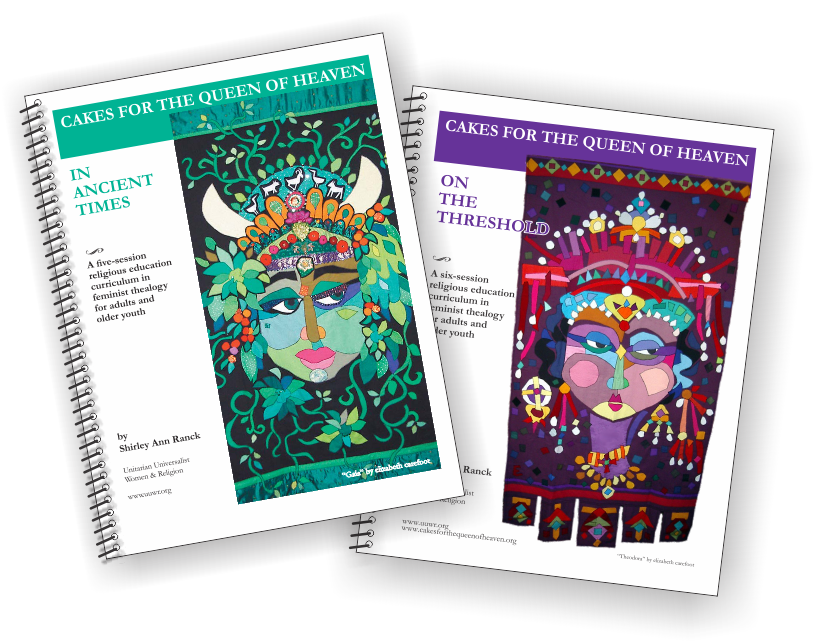Editor's Notes, July 2015: I find it interesting in reading Phyllis Rickter's 1989 letter that the roles are almost reversed in 2015. While UU Women's Federation remains one of only TWO Associate Organizations, in 1996 the UUWR Committee was "sunsetted," meaning no longer a UUA staff-supported Committee. UUWR applied for and was granted "UUA Independent Affiliate Organization" status in 2002. UUWR was further removed from UUA organizational structure when all 60 or so of the Independent Affiliates were re-named "Related Organizations" a few years later. These groups no longer received discounts on GA exhibit booths, or a guaranteed program slot for GA, and their status was relegated to a listing on the UUA website.
Continental UUW&R continues to operate independently, within a loose network of District W&R groups and other like-minded UU women's organizations. UUW&R currently focuses on finding and providing feminist thealogy and women's spirituality resources for congregations and women's groups; UUWF continues to follow their mission of "advancing justice for women and girls and supporting their spiritual growth," supported by individual memberships and an endowment that allows them to give grants to projects that align with their mission.
While over the years, communication "has not always been good," to put it mildly, today the UUWF and UUWR are forging new relationships and brainstorming possible collaborations. We worked side-by-side exhibit booths at General Assembly 2015, and have some ideas in the works for 2016. Stay tuned!
-- Gretchen
---------------------------------------------------------
UUWF - Unitarian Universalist Women's Federation
Phyllis Rickter, President
May 5, 1989
ON THE SIMILARITIES AND DIFFERENCES BETWEEN UUWF AND WOMEN/RELIGION COMMITTEE
One of the most frequent questions asked me these days is "What's the connection between the UU Women's Federation and the Women and Religion Committee?" Or sometimes it's, "Why do we need two groups for UU women?" Or, "Can I belong to both?" Or, "How are they different?" It is good that Unitarian Universalists are asking these questions, and I am glad to have the opportunity to describe what I believe the roles of each organization to be.
First of all, the UUWF is an autonomous organization of church women's groups and individual women and men across the continent. We were formed in 1963 out of the merger of two historic women's groups, the Association of Universalist Women, founded in 1869, and the Alliance of Unitarian and Other Liberal Christian Women, founded in 1890. We are one of three associate members of the UUA; and have our own structure, funds, and staff. Our members determine the direction of our work.
Our current programs include the Feminist Theology Award, a yearly award to women doing scholarly, theological, and accessible projects on feminist theology from a UU perspective; the Circuit Rider program; Clara Barton Sisterhood; representation of UU women in national groups like RCAR (Religious Coalition for Abortion Rights), UU Peace Network, Children's Defense Fund, and several others. Members of our UUWF units receive a newsletter six times a year; in addition, individual members receive a mailing called "The Women's View", published quarterly with news of womens' activities.
In 1977 women of the Lexington, Mass. UUWF brought to the General Assembly a resolution calling upon all to examine their religious beliefs and the extent to which these beliefs influence sex-role stereotypes. Special emphasis was placed on the use of inclusive language and the avoidance of sexist words and images. A committee was formed to implement this resolution. Today that committee - the Women and Religion Committee - is a committee of the UUA, appointed every two years by the Committee on Committees. Its present work involves implementation of the Resolution through work on the Sexism Audit done in 1987-88. As time went on and women everywhere began to examine the sexist assumptions in their own lives and in their churches, groups began to form at the local level called Women and Religion Committees. Often these were the same women as those in UUWF units; sometimes not.
Sometimes the groups were divided by age; some churches have both groups.
Communication at all levels has not always been good.
Special efforts began in 1984 to bring the Continental Women and Religion Committee and the UUWF Administrative Board into closer relationship. Presently we meet together at least once a year; collaborate on organizing the Connections Room at General Assembly; and work closely on projects related to the elimination of sexism. Beginning in April, 1989 the UUWF's newsletter, the COMMUNICATOR, carries two pages of news from Women and Religion Committees at the local and district level.
Are both groups needed? I would say so. The UUWF, being autonomous, can often deal with outside groups in a way that the Women and Religion Committee cannot. The Women and Religion Committee, being a part of the UUA structure, can relate to the UUA Board and staff in a way not possible for a group outside that structure. More important than these reasons, however, is the opportunity both groups receive to network more broadly than one could do, to reach people with special interests in issues of sexism, and to tell the story of feminism to more traditional women.
Perhaps someday the place of women will be so secure in our homes, churches, and in the larger community that we won't need to speak so urgently of our needs. Until that time, the UUWF celebrates its work with the Women and Religion Committee and pledges to continue this collaboration.



